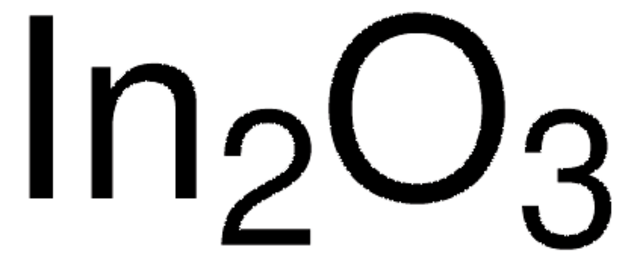Kluczowe dokumenty
639303
Indium tin oxide coated PET
surface resistivity 60 Ω/sq, L × W × thickness 1 ft × 1 ft × 5 mil, sheet
Synonim(y):
ITO-PET, Polyethylene terephthalate film, ITO coated
About This Item
Polecane produkty
Formularz
sheet
rezystywność powierzchniowa
60 Ω/sq
dł. × szer. × grubość
1 ft × 1 ft × 5 mil
przepuszczalność
550 nm, >78%
ciąg SMILES
O=[In]O[In]=O.O=[Sn]=O
InChI
1S/2In.5O.Sn
Klucz InChI
LNNWKAUHKIHCKO-UHFFFAOYSA-N
Szukasz podobnych produktów? Odwiedź Przewodnik dotyczący porównywania produktów
Opis ogólny
Zastosowanie
Micro mechanical properties of ITO-PET were investigated. Electrical resistance of ITO-PET increases in case of degradation. ITO-PET was used as an electrode in the electrochemical measurements in a study of biosensors composed of polymer brushes. ITO microelectrodes were studied as an “electronic tongue” for analyte recognition. The sheet resistance of ITO, after bending to a radius of 25 mm was investigated, for its use for flexible optical devices. Giant unilamellar vesicle (GUVs) were produced on ITO coated glass slides by drying droplets of the FhuA proteoliposomes.
Cechy i korzyści
Właściwości fizyczne
Ilość
Kod klasy składowania
13 - Non Combustible Solids
Klasa zagrożenia wodnego (WGK)
WGK 3
Temperatura zapłonu (°F)
Not applicable
Temperatura zapłonu (°C)
Not applicable
Środki ochrony indywidualnej
dust mask type N95 (US), Eyeshields, Gloves
Wybierz jedną z najnowszych wersji:
Masz już ten produkt?
Dokumenty związane z niedawno zakupionymi produktami zostały zamieszczone w Bibliotece dokumentów.
Produkty
Pochodne bis-styrylobenzenu mają obiecujące właściwości w zakresie niskich progów laserowania. Omówiono rozważania projektowe dotyczące cząsteczek emitujących światło organiczne.
Organic Semiconductor Laser Materials
Organic photovoltaics (OPVs) represent a low-cost, lightweight, and scalable alternative to conventional solar cells. While significant progress has been made in the development of conventional bulk heterojunction cells, new approaches are required to achieve the performance and stability necessary to enable commercially successful OPVs.
Przezroczysta elektroda przewodząca (TCE) jest niezbędnym elementem różnych urządzeń optoelektronicznych, takich jak ogniwa słoneczne, wyświetlacze ciekłokrystaliczne (LCD), diody elektroluminescencyjne (LED) i ekrany dotykowe.
Nasz zespół naukowców ma doświadczenie we wszystkich obszarach badań, w tym w naukach przyrodniczych, materiałoznawstwie, syntezie chemicznej, chromatografii, analityce i wielu innych dziedzinach.
Skontaktuj się z zespołem ds. pomocy technicznej



